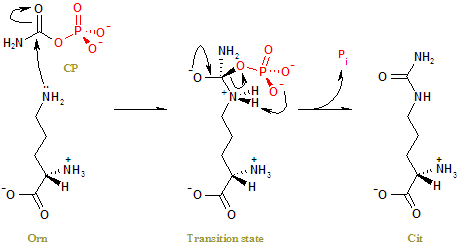
Ornithine transcarbamylase
Encyclopedia
Ornithine transcarbamoylase (OTC) (also called ornithine carbamoyltransferase) is an enzyme
that catalyzes the reaction between carbamoyl phosphate
(CP) and ornithine
(Orn) to form citrulline
(Cit) and phosphate (Pi). In plants and microbes, OTC is involved in arginine
(Arg) biosynthesis, whereas in mammals it is located in the mitochondria and is part of the urea cycle
.
The active sites are located at the interface between the protein monomers.

 If a person is deficient in OTC, ammonia levels will build up, and this will cause neurological problems. Levels of the amino acid
If a person is deficient in OTC, ammonia levels will build up, and this will cause neurological problems. Levels of the amino acid
s, glutamate, and alanine
will be increased (as these are the amino acids that receive nitrogen from others).
Levels of urea cycle
intermediates may be decreased, as carbamoyl phosphate cannot replenish the cycle. The carbamoyl phosphate instead goes into the uridine monophosphate
synthetic pathway. Here orotic acid (one step of this alternative pathway) levels in the blood are increased.
A potential treatment for the high ammonia levels is to give sodium benzoate
, which combines with glycine
to produce hippurate, at the same time removing an ammonium group.
Enzyme
Enzymes are proteins that catalyze chemical reactions. In enzymatic reactions, the molecules at the beginning of the process, called substrates, are converted into different molecules, called products. Almost all chemical reactions in a biological cell need enzymes in order to occur at rates...
that catalyzes the reaction between carbamoyl phosphate
Carbamoyl phosphate
Carbamoyl phosphate is an anion of biochemical significance. In land-dwelling animals it is an intermediary metabolite participating in the nitrogen disposal through in the urea cycle and the synthesis of pyrimidines....
(CP) and ornithine
Ornithine
Ornithine is an amino acid that plays a role in the urea cycle.-Role in urea cycle:L-Ornithine is one of the products of the action of the enzyme arginase on L-arginine, creating urea. Therefore, ornithine is a central part of the urea cycle, which allows for the disposal of excess nitrogen....
(Orn) to form citrulline
Citrulline
The organic compound citrulline is an α-amino acid. Its name is derived from citrullus, the Latin word for watermelon, from which it was first isolated in 1930.It has the idealized formula H2NCNH3CHCO2H...
(Cit) and phosphate (Pi). In plants and microbes, OTC is involved in arginine
Arginine
Arginine is an α-amino acid. The L-form is one of the 20 most common natural amino acids. At the level of molecular genetics, in the structure of the messenger ribonucleic acid mRNA, CGU, CGC, CGA, CGG, AGA, and AGG, are the triplets of nucleotide bases or codons that codify for arginine during...
(Arg) biosynthesis, whereas in mammals it is located in the mitochondria and is part of the urea cycle
Urea cycle
The urea cycle is a cycle of biochemical reactions occurring in many animals that produces urea from ammonia . This cycle was the first metabolic cycle discovered , five years before the discovery of the TCA cycle...
.
Structure
OTC is a trimer. The monomer unit has a CP-binding domain and an amino acid-binding domain. Each of the two discrete substrate-binding domains (SBDs) have an α/β topology with a central β-pleated sheet embedded in flanking α-helices.The active sites are located at the interface between the protein monomers.
Function

Deficiency

Amino acid
Amino acids are molecules containing an amine group, a carboxylic acid group and a side-chain that varies between different amino acids. The key elements of an amino acid are carbon, hydrogen, oxygen, and nitrogen...
s, glutamate, and alanine
Alanine
Alanine is an α-amino acid with the chemical formula CH3CHCOOH. The L-isomer is one of the 20 amino acids encoded by the genetic code. Its codons are GCU, GCC, GCA, and GCG. It is classified as a nonpolar amino acid...
will be increased (as these are the amino acids that receive nitrogen from others).
Levels of urea cycle
Urea cycle
The urea cycle is a cycle of biochemical reactions occurring in many animals that produces urea from ammonia . This cycle was the first metabolic cycle discovered , five years before the discovery of the TCA cycle...
intermediates may be decreased, as carbamoyl phosphate cannot replenish the cycle. The carbamoyl phosphate instead goes into the uridine monophosphate
Uridine monophosphate
Uridine monophosphate, also known as 5'-uridylic acid and abbreviated UMP, is a nucleotide that is used as a monomer in RNA. It is an ester of phosphoric acid with the nucleoside uridine...
synthetic pathway. Here orotic acid (one step of this alternative pathway) levels in the blood are increased.
A potential treatment for the high ammonia levels is to give sodium benzoate
Sodium benzoate
Sodium benzoate has the chemical formula NaC6H5CO2; it is a widely used food preservative, with E number E211. It is the sodium salt of benzoic acid and exists in this form when dissolved in water. It can be produced by reacting sodium hydroxide with benzoic acid.-Uses:Sodium benzoate is a...
, which combines with glycine
Glycine
Glycine is an organic compound with the formula NH2CH2COOH. Having a hydrogen substituent as its 'side chain', glycine is the smallest of the 20 amino acids commonly found in proteins. Its codons are GGU, GGC, GGA, GGG cf. the genetic code.Glycine is a colourless, sweet-tasting crystalline solid...
to produce hippurate, at the same time removing an ammonium group.

